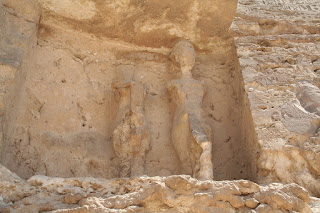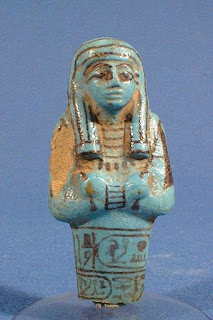small temple Amarna
jueves, 31 de diciembre de 2020
Marion Dunham, Mrs. Charles Burney, Dows Dunham, Rosalind Moss and Jack Cooney at Philae
Lunch in the Valley of the Kings, L to R: James Poitrine, Harry Burton, Alfred Lucas, Arthur Callender, Arthur Mace, Howard Carter and Alan Gardiner
Lunch in the Valley of the Kings, L to R: James Poitrine, Harry Burton, Alfred Lucas, Arthur Callender, Arthur Mace, Howard Carter and Alan Gardiner
miércoles, 30 de diciembre de 2020
Limestone trial piece of a private person
Limestone trial piece of a private person. There is a carved head of a princess on the reverse. The profile head of the person, facing left, was finally carved. Revered: roughly carved head of a royal princess. There are 2 nb-hieroglyphs, 2 eyes, and 3 and a half pairs of lips. Reign of Akhenaten. From Amarna, Egypt. Petrie Museum of Egyptian Archaeology, London. With thanks to the Petrie Museum of Egyptian Archaeology, UCL.
House Altar from Amarna
House Altar from Amarna with Name of God Aten in Cartouche - 18th Dynasty, Staatliches Museum Ägyptischer Kunst München, ÄS 2823
domingo, 27 de diciembre de 2020
Figure from a mummy-bead net: textcolumn with Anubis
papyrus
viernes, 25 de diciembre de 2020
network of tubular beads
Sekhmet
Head and upper body of the goddess Sekhmet, Egypt, 18th dynasty, reign of Amenhotep III, 1390-1352 BCE.
The Kelvingrove Art Gallery and Museum, Glasgow, Scotland, UK
Detalle de anudado de la shenti del inspector de escribas Raherka
Detalle de anudado de la shenti del inspector de escribas Raherka (c. 2350 a. C.). Museo del Louvre.
jueves, 24 de diciembre de 2020
Stela showing Horus on the crocodiles
martes, 22 de diciembre de 2020
A STUDY OF A SELECTED GROUP OF THIRD INTERMEDIATE PERIOD MUMMIES IN THE BRITISH MUSEUM
vase
Globular container with a flat bottom and a small convex lip. The quite large opening at the top is closed with a flat disc made of a grey-green hard stone inset into the neck of the vessel. The narrow hole nonetheless allows for the insertion of the stick used for applying the cosmetic, which was probably kohl.
Present location |
INSTITUT DE PAPYROLOGIE ET D'ÉGYPTOLOGIE, UNIVERSITÉ DE LILLE III [02/049] LILLE |
Inventory number |
L 0627 |
Dating |
CLASSICAL KERMA |
Archaeological Site |
MIRGISSA |
Category |
VASE |
Material |
CALCITE/ALABASTER; SERPENTINITE |
Technique |
POLISHED; HEWN |
Height |
7.3 cm |
Bibliography
- Vila André, "Le cimetière Kerma", dans J. Vercoutter, Mirgissa I, Paris, 1970, p.238, fig.8e.
- Gratien Brigitte et Le Saout Françoise, Nubie, les cultures antiques du Soudan, catalogue d'exposition, Lille, 1994, p.152, n°226.
domingo, 20 de diciembre de 2020
The funeral procession on water
Present location
Inventory number
Dating
Archaeological Site
Category
Material
Technique
Height
Width
Bibliography
- L. Speleers, Recueil des inscriptions égyptiennes des Musées Royaux du Cinquantenaire à Bruxelles, Bruxelles 1923, 40 nº 154
- A. Mekhitarian, Fragments de peintures thébaines, Serapis 6 (1980) 88
- L. Manniche, Lost Tombs, Londres-New York 1988, 192-193
- J.-Ch. Balty, e.a., Koninklijke Musea voor Kunst en Geschiedenis, Brussel, Oudheid - Musées Royaux d'Art et d'Histoire, Bruxelles, Antiquité - The Royal Museums of Art and History, Brussels, Antiquity, Bruxelles 1988, 26-28
ostrich egg
Present location
Inventory number
Dating
Archaeological Site
Category
Material
Technique
Height
Width
Bibliography
- S. Hendrickx, in T. Phillips, Africa. The Art of a Continent (Exposition Londres 1995), Munich-New York-Londres 1995, 78 n° 1.37
sábado, 19 de diciembre de 2020
Shabti of king Sethos I
Present location
Inventory number
Dating
Archaeological Site
Category
Material
Technique
Height
Width
Depth
Bibliography
- W. Seipel, Ägypten. Götter, Gräber und die Kunst. 4000 Jahre Jenseitsglaube (Exposition), Linz 1989, I 210 n° 168
- Le Roman de la momie. Les amours d'une princesse égyptienne (Exposition Saint-Gérard de Brogne), Namur 1997, 139 n° 168
viernes, 18 de diciembre de 2020
Decorated vessel of the Predynastic Period
Terracotta statuette of two actors
Tomb statue of Nefer-hetepes
Tomb statue of Nefer-hetepes
Nefer-hetepes is represented standing against a back slab reaching up to her shoulders. Her legs are together, and her arms are pendant beside her body with empty, open hands. She is dressed in an ankle-length dress with shoulder straps, a broad collar and a long wig.
Present location |
PELIZAEUS-MUSEUM [04/030] HILDESHEIM |
Inventory number |
0418 |
Dating |
6TH DYNASTY |
Archaeological Site |
GIZA NECROPOLIS |
Category |
STATUE |
Material |
LIMESTONE; UNSPECIFIED |
Technique |
SCULPTURED; PAINTED; ENGRAVED |
Height |
53.6 cm |
Width |
15 cm |
Depth |
24 cm |
Translation
"[1] 'Miteret' (a woman's title) Nefer-hetepes:"
Bibliography
- Roeder, G., Die Denkmäler des Pelizaeus-Museums zu Hildesheim, Hildesheim 1921, S. 50, Abb. 8.
- Kayser, H., Die ägyptischen Altertümer im Roemer-Pelizaeus-Museum in Hildesheim, Hildesheim 1973, S. 47, Farbtf. 2.
- Porter, B. & Moss, R.L.B., Topographical Bibliography of Ancient Egyptian Hieroglyphic Texts, Reliefs, and Paintings, vol. III².1 : Memphis, Oxford 1974, S. 113.
- Martin-Pardey, E., Plastik des Alten Reiches : Teil 1 (Corpus Antiquitatum Aegyptiacarum: Pelizaeus-Museum Hildesheim, Lieferung 1), Mainz 1977, S. 83-90.
- Seipel, W., Bilder für die Ewigkeit : 3000 Jahre ägyptischer Kunst, Konstanz 1983, Kat.-Nr. 39.
- Eggebrecht, A. (Hrsg.), Das Alte Reich : Ägypten im Zeitalter der Pyramiden, Hildesheim - Mainz 1986, Kat.-Nr. 27.
- Symmetrie in Kunst, Natur und Wissenschaft : Band 2; Kunst, Darmstadt 1986, Kat.-Nr. 164.
- Steindorff, G. & Hölscher, U. (hrsg. von A. Grimm), Die Mastabas westlich der Cheopspyramide : nach den Ergebnissen der in den Jahren 1903-1907 im Auftrag der Universität Leipzig und des Hildesheimer Pelizaeus-Museums unternommenen Grabungen in Gîza (Münchener Ägyptologische Untersuchungen 2), Frankfurt 1991, S. 60 (Anm. 34).
http://www.globalegyptianmuseum.org/detail.aspx?id=10538
Group statue of Pepi and Ra-shepses
Present location
Inventory number
Dating
Archaeological Site
Category
Material
Technique
Height
Width
Depth
Translation
"[1] Her son Ra-shepses"
"[2] The royal acquaintance Pepi"
"[3] Royal wab-priest Ra-shepses"
"[4] Ra-shepses"
Bibliography
- Roeder, G., Die Denkmäler des Pelizaeus-Museums zu Hildesheim, Hildesheim 1921, S. 50-51.
- Kayser, H., Die ägyptischen Altertümer im Roemer-Pelizaeus-Museum in Hildesheim, Hildesheim 1973, S. 46, Abb. 26.
- Porter, B. & Moss, R.L.B., Topographical Bibliography of Ancient Egyptian Hieroglyphic Texts, Reliefs, and Paintings, vol. III².1 : Memphis, Oxford 1974, S. 110.
- Martin-Pardey, E., Plastik des Alten Reiches : Teil 1 (Corpus Antiquitatum Aegyptiacarum: Pelizaeus-Museum Hildesheim, Lieferung 1), Mainz 1977, S. 39-46.
- Seipel, W., Bilder für die Ewigkeit : 3000 Jahre ägyptischer Kunst, Konstanz 1983, Kat.-Nr. 40.
- Eggebrecht, A. (Hrsg.), Nofret - Die Schöne : Die Frau im Alten Ägypten; "Wahrheit" und Wirklichkeit, Hildesheim - Mainz 1985, Kat.-Nr. 104.
- Eggebrecht, A. (Hrsg.), Das Alte Reich : Ägypten im Zeitalter der Pyramiden, Hildesheim - Mainz 1986, Kat.-Nr. 16.
- Rößler-Köhler, U., Die rundplastische Gruppe der Frau Pepi und des Mannes Ra-Schepses : Bemerkungen zur Ikonographie von Familiendarstellungen des Alten Reiches, in: Mitteilungen des Deutschen Archäologischen Instituts, Abteilung Kairo 45 (1989), Mainz 1990, S. 261-274, Taf. 32-35.
- Steindorff, G. & Hölscher, U. (hrsg. von A. Grimm), Die Mastabas westlich der Cheopspyramide : nach den Ergebnissen der in den Jahren 1903-1907 im Auftrag der Universität Leipzig und des Hildesheimer Pelizaeus-Museums unternommenen Grabungen in Gîza (Münchener Ägyptologische Untersuchungen 2), Frankfurt 1991, S. 33 (Anm. 16).


































